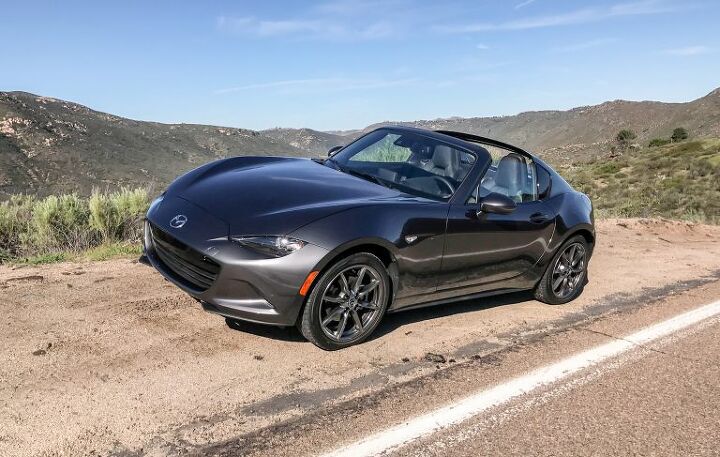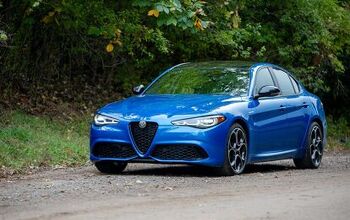2017 Mazda MX-5 RF First Drive Review - Adding Balance

Let’s get right to it. Retractable hardtop MX-5 owners will pay a 113-pound penalty for their motorized, targa-topped fun. 113 pounds. Mazda engineers and marketers do not take that sum lightly. But we can, because unless you are stripping down your Miata for competitive track work — in which case you will select the softtop anyway — you will not feel the difference.
The hardtop does absolutely nothing to diminish the balanced, driver focused, analog pleasure of the fourth generation MX-5. And for the purists, consider your baby may one day only be visible in the rearview mirror if Mazda can not expand the audience for this little icon.
Last year, Mazda sold its one-millionth MX-5. According to the Guinness Book of World Records, it is the best-selling two-seat sports car in history. However, MX-5 sales have not rebounded since the recession. In the five healthy years leading up to 2007, Mazda shifted more than 34,000 MX-5’s across the world each year. Between 2008 and 2012, global sales averaged just 20,700 units annually. And since 2013, global sales have struggled to average 20,000 each year. Depressed volumes may not justify the high cost of maintaining and developing this storied nameplate. Mazda must broaden the MX-5’s appeal to amortize its investment across more units.
Roadster purist or not, we need the Fiat 124 and the RF to secure Mazda’s ongoing commitment to this legend.
The MX-5 was thoroughly redesigned for 2016. And the 2017 RF brings more change. There is, of course, the aluminum, steel, and SMC plastic motorized retractable hardtop that replaces the bubble top afterthought offered on the last generation car. Designer Julien Montousse did an amazing job integrating the new top into Derek Jenkins’s original ND design. Montousse worked within the KODO — Soul of Motion — design language to deliver a sleek solution wholly integrated into the car’s bodywork in a way that suggests it could have been its native form.
Changes to the RF versus the softtop are minor but run deeper than motors and sheet metal. The objective of these changes was to make the hardtop drive like the softtop. According to Mazda, engineers retuned the RF’s rear suspension bushings and bump stops to “smooth out the transition to oversteer, making it easier to balance the car right on the grip limit.” Mission accomplished. Steering calibration was also adjusted to reduce on-center friction. None to speak of. For all but the most hypersensitive and precise professionals, the RF continues to deliver the balanced, uplifting experience that makes the softtop such a laugh.
Depress the open/close button and the MX-5 RF roof actuates in 13 seconds. No latching or unlatching required. Just hold the button until you hear the tone. You may do so at up to 6 miles per hour. And the hardtop does little to reduce the volume of the softtop’s diminutive trunk.
The RF adopts almost everything from the softtop, including its 2.0-liter SKYACTIV-G four-cylinder, delivering 155 horsepower and 148 lb-ft of torque, as well as its glorious six-speed manual transmission (and an optional automatic). But Mazda did not elect to make RF available in MX-5’s base Sport trim. Hardtop shoppers must move up to the Club, which starts at $31,555, or $2,955 more than its softtop cousin. The top of the line Grand Touring RF starts at $32,620 plus $875 destination fee, or $33,825 if you insist on the sacrilege of two pedals. All MX-5 RF’s deliver an EPA estimated 26 miles per gallon city. Manual transmission cars are good for 33 mpg highway, or 35 mpg for automatics.
Neither version of the MX-5 may be for you. Two seats may not suit your lifestyle, the brand may be too peripheral, or the styling may not be to your liking. Regardless, if you are an enthusiast, you must recognize its unique value proposition. MX-5 is one of very few cars designed narrowly and unapologetically for drivers. Mazda is nearly alone in carrying the torch of accessible performance, and the RF does nothing to diminish the MX-5’s balance and everything to broaden its appeal. Cheers to Mazda for getting the hardtop right.

Twenty year auto industry professional. Currently CEO at Turbo International, the premier American manufacturer of OEM replacement turbochargers for the global aftermarket.
More by Seth Parks
Latest Car Reviews
Read moreLatest Product Reviews
Read moreRecent Comments
- Kjhkjlhkjhkljh kljhjkhjklhkjh I'd rather they have the old sweep gauges, the hhuuggee left to right speedometer from the 40's and 50's where the needle went from lefty to right like in my 1969 Nova
- Buickman I like it!
- JMII Hyundai Santa Cruz, which doesn't do "truck" things as well as the Maverick does.How so? I see this repeated often with no reference to exactly what it does better.As a Santa Cruz owner the only things the Mav does better is price on lower trims and fuel economy with the hybrid. The Mav's bed is a bit bigger but only when the SC has the roll-top bed cover, without this they are the same size. The Mav has an off road package and a towing package the SC lacks but these are just some parts differences. And even with the tow package the Hyundai is rated to tow 1,000lbs more then the Ford. The SC now has XRT trim that beefs up the looks if your into the off-roader vibe. As both vehicles are soft-roaders neither are rock crawling just because of some extra bits Ford tacked on.I'm still loving my SC (at 9k in mileage). I don't see any advantages to the Ford when you are looking at the medium to top end trims of both vehicles. If you want to save money and gas then the Ford becomes the right choice. You will get a cheaper interior but many are fine with this, especially if don't like the all touch controls on the SC. However this has been changed in the '25 models in which buttons and knobs have returned.
- Analoggrotto I'd feel proper silly staring at an LCD pretending to be real gauges.
- Gray gm should hang their wimpy logo on a strip mall next to Saul Goodman's office.






































Comments
Join the conversation
This is a very attractive car. I am impressed that compared to the first generation this car is shorter, lighter and much more powerful. And the top does not take trunk space, unlike the German origami tops. Unrelated: the article notes that the Guinness Book of World Records considers the Miata the best-selling two seat sports car ever with over a million sold. The Corvette, which has always had two seats, passed the million mark in 1992 and is still going strong. Is this because some year the Corvette was not available as a roadster but only a coupe?
I just sat in one of these at the annual local spring car show. The RT is more attractive in the flesh than in photos. Seat, wheel, shifter and pedals all feel great and are perfectly placed. The windshield frame is thick, blocks visibility, and the top edge of it is too low and close to my head. I think you'd have to be around 5'8" or so to feel comfortable in this thing. I'm 5'11". I suspect this would be unchanged in the soft-top version.